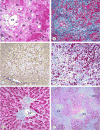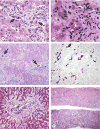Hepatobiliary complications of hematopoietic cell transplantation, 40 years on
- PMID: 20373370
- PMCID: PMC2914093
- DOI: 10.1002/hep.23533
Hepatobiliary complications of hematopoietic cell transplantation, 40 years on
Abstract
Liver problems caused by infection, cholestasis and sinusoidal liver injury in the months following HCT have become less frequent because of preventive and pre-emptive strategies. When patients develop jaundice after transplant, the time to search for treatable causes is early in the course of jaundice, as the risk of mortality rises steeply with small increments of serum bilirubin above normal. Chronic hepatitis C, persistent GVHD, cirrhosis and hepatocellular carcinoma are significant liver problems in the longest-lived survivors of HCT.
Figures



References
-
- Lau GKK, Strasser SI, McDonald GB. Hepatitis virus infections in patients with cancer. In: Wingard JR, Bowden RA, editors. Management of Infection in Oncology Patients. London, UK: Martin Dunitz; 2003. pp. 321–342.
-
- Ruutu T, Eriksson B, Remes K, Juvonen E, Volin L, Remberger M, Parkkali T, et al. Ursodeoxycholic acid for the prevention of hepatic complications in allogeneic stem cell transplantation. Blood. 2002;100:1977–1983. - PubMed
-
- Marotta G, Tozzi M, Sammassimo S, Defina M, Raspadori D, Gozzetti A, Lauria F. Complete resolution of hepatic aspergillosis after non-myeloablative hematopoietic stem cell transplantation in a patient with acute myeloid leukemia. Hematology. 2005;10:383–386. - PubMed
-
- Deschenes M, Laneuville P. Pre-emptive use of lamivudine in bone marrow transplantation with chronic hepatitis B virus infection. Hepatology. 2004;39:867–868. - PubMed
-
- Lau GK, Suri D, Liang R, Rigopoulou EI, Thomas MG, Mullerova I, Nanji A, et al. Resolution of chronic hepatitis B and anti-HBs seroconversion in humans by adoptive transfer of immunity to hepatitis B core antigen. Gastroenterology. 2002;122:614–624. - PubMed
Publication types
MeSH terms
Grants and funding
LinkOut - more resources
Full Text Sources
Medical
